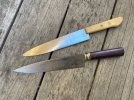-
The BladeForums.com 2024 Traditional Knife is available! Price is $250 ea (shipped within CONUS).
Order here: https://www.bladeforums.com/help/2024-traditional/
You are using an out of date browser. It may not display this or other websites correctly.
You should upgrade or use an alternative browser.
You should upgrade or use an alternative browser.
Gaucho knives and cuchillos criollos of South America
- Thread starter CelloDan
- Start date
Trubetzkoy
Basic Member
- Joined
- Jun 3, 2022
- Messages
- 424
Very handsome. Any idea about the number painted onto the blade? Also, is the bolster brass, or nickel silver?The cuchilla and cuchillo de campo were delivered this afternoon.
They're supposed to both be Mann & Federlein knives, but neither blade is marked.
View attachment 2867966
Additional thoughts to follow.
kamagong
Gold Member
- Joined
- Jan 13, 2001
- Messages
- 10,966
No idea as to the meaning of the markings on the blade, 22312/8. I wonder if this knife was a saleman's sample, with the 22312 referring to the model number, and the 8 indicating the size of the blade in inches.
The bolster is nickel silver.
The bolster is nickel silver.
screened porch
Basic Member
- Joined
- Feb 19, 2012
- Messages
- 19,335
That gaucho knife life book has an article written by a British adventurer in 1925, which says, "Actually the knife is the favorite weapon in Argentina: an ordinary long knife, carried in the belt, with which the men eat, skin their meat, and kill each other."
Even moderate fanciness may have been more rare than we think.

Even moderate fanciness may have been more rare than we think.

kamagong
Gold Member
- Joined
- Jan 13, 2001
- Messages
- 10,966
Even moderate fanciness may have been more rare than we think.

You may be on to something there. The Bokers and the Herders and their like grab our attention, but I'm sure many gauchos carried more simple knives.
The cuchilla and cuchillo de campo are certainly modest designs. Basic construction with not much steel used. The blades on my examples are 2 mm and 2.5 mm thick respectively. Not nearly as strong as the blades on my Simbra and Arbolito.
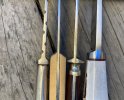
I'm perplexed as to why the factory put a swedge on the cuchilla. Why bother with such thin stock?
Trubetzkoy
Basic Member
- Joined
- Jun 3, 2022
- Messages
- 424
That actually seems pretty plausible. That would explain the lack of stamp, too.No idea as to the meaning of the markings on the blade, 22312/8. I wonder if this knife was a saleman's sample, with the 22312 referring to the model number, and the 8 indicating the size of the blade in inches.
For sure, regular butcher and chef knives were and still are common in South America -- especially rural areas -- as general-use tools. Some of them have specifically South American stamps, too. Here's a Guyot cuchilla imported by E. Montagnac from Buenos Aires, sold a few years ago by a fella called Jair Caetano on Facebook:That gaucho knife life book has an article written by a British adventurer in 1925, which says, "Actually the knife is the favorite weapon in Argentina: an ordinary long knife, carried in the belt, with which the men eat, skin their meat, and kill each other."
Even moderate fanciness may have been more rare than we think.


I wouldn't say fancy knives were rare at all though, given how many old pieces one sees floating around. It's just that the fancier knives were not really for the regular gaucho, but for more aristocratic, or even middle-class, types.
I think it was common with butchering-types of knives, especially if done on only one side of the blade. I've seen it on several old butcher and chef knives I've owned, American, British, etc., all with rather thin blades.I'm perplexed as to why the factory put a swedge on the cuchilla. Why bother with such thin stock?
kamagong
Gold Member
- Joined
- Jan 13, 2001
- Messages
- 10,966
I think it was common with butchering-types of knives, especially if done on only one side of the blade. I've seen it on several old butcher and chef knives I've owned, American, British, etc., all with rather thin blades.
Hit it right on the nose. The cuchilla is only swedged on one side.
oldmanwilly
Gold Member
- Joined
- Mar 7, 2014
- Messages
- 4,086
That gaucho knife life book has an article written by a British adventurer in 1925, which says, "Actually the knife is the favorite weapon in Argentina: an ordinary long knife, carried in the belt, with which the men eat, skin their meat, and kill each other."
Even moderate fanciness may have been more rare than we think.

You may be on to something there. The Bokers and the Herders and their like grab our attention, but I'm sure many gauchos carried more simple knives.
The cuchilla and cuchillo de campo are certainly modest designs. Basic construction with not much steel used. The blades on my examples are 2 mm and 2.5 mm thick respectively. Not nearly as strong as the blades on my Simbra and Arbolito.
View attachment 2868277
I'm perplexed as to why the factory put a swedge on the cuchilla. Why bother with such thin stock?
That actually seems pretty plausible. That would explain the lack of stamp, too.
For sure, regular butcher and chef knives were and still are common in South America -- especially rural areas -- as general-use tools. Some of them have specifically South American stamps, too. Here's a Guyot cuchilla imported by E. Montagnac from Buenos Aires, sold a few years ago by a fella called Jair Caetano on Facebook:


I wouldn't say fancy knives were rare at all though, given how many old pieces one sees floating around. It's just that the fancier knives were not really for the regular gaucho, but for more aristocratic, or even middle-class, types.
I think it was common with butchering-types of knives, especially if done on only one side of the blade. I've seen it on several old butcher and chef knives I've owned, American, British, etc., all with rather thin blades.
I can't help but notice some parallels from this discussion that relate to the historical cowboys in the US. We may tend to romanticize them and think that everyone carried a Colt revolver and a Bowie knife, but in reality most of them were dirt poor and probably had nothing more than a reata and a Russell-Green River butcher knife (or similar). Heck, the original Bowie knife was, by most accounts, little more than a large butcher knife that we might now refer to as a breaking knife or scimeter. The fancy Bowies from Sheffield were reserved for the dudes who could afford not to use them too much. Even now, it seems that most working cowboys use some flavor of Case trapper or cheap modern folder that is easily accessible at a hardware or feed store. Then as now: if it is cheap, available, and functional then that's what gets used.
Trubetzkoy
Basic Member
- Joined
- Jun 3, 2022
- Messages
- 424
Another interesting cuchilla from a Facebook listing, with a fancier touch:

Not sure if everything is original, but both the handle (marked "800") and the sheath (marked "11" matching the length of the blade in inches) appear old and European-made.

Not sure if everything is original, but both the handle (marked "800") and the sheath (marked "11" matching the length of the blade in inches) appear old and European-made.
kamagong
Gold Member
- Joined
- Jan 13, 2001
- Messages
- 10,966
I like that Henckels
T
Trubetzkoy
. I really enjoy the great variety in cuchillos criollos and if you gathered a hundred gauchos together there is a fair chance that each one of them would have a different knife.
kamagong
Gold Member
- Joined
- Jan 13, 2001
- Messages
- 10,966
It was a pretty hot day today, so I finally got off my duff and decided to fix the loose handle on my Simbra.
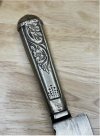
I started by leaving the Simbra in my solarium for a few hours while we took out my mom for a Mother's Day brunch, in the hopes of loosening the lacre, or cutler's resin. Upon return the knife and handle was much the same, I could wiggle the handle and make the gap appear or disappear depending on which direction force was applied.
I then decided to take stronger measures. Measuring the inside of my toaster oven, I confirmed that it was large enough to fit the Simbra. I set the oven to 225°F. I know that you can risk ruining the temper of a blade starting at 400°F, so I didn't want to go anywhere near that. After 10 minutes I checked the knife, and the handle had loosened considerably. The lacre was now the consistency of soft clay and I was able to pull it entirely off. Apparently the peened end is merely a cosmetic touch, and the handle of this knife is held in place by nothing more than cutler's resin. Too stupid to leave well enough alone, I increased the temperature of the oven to 275°F, in the hopes of melting the lacre a bit and having it reform around the tang. It worked all right, but I got distracted and left it in the oven a little too long, realizing my mistake when I noticed a burning wax smell coming from the kitchen. The lacre melted and was slowly dripping out of the handle. I grabbed the knife with a damp shop rag and stood it up in my hardwood chopping block, doing my best to align the blade and handle straight. I think I did a fair job, but I now had hardened lacre covering parts of the handle and the botón. It's taken me the better part of an hour removing the red material. I've gotten most of it off, but there is still some near the handle/blade junction. I think I'll leave it be as a reminder of my foolish absentmindedness.
I like this knife much better now that I've remedied the rattle.
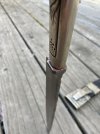
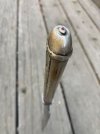
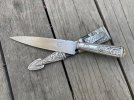
Here's a family picture of my medium-sized cuchillos criollos.
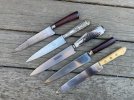
1. Artisan forged
2. Tandil-made
3. Solingen import
4. Cuchillo de campo
5. Cuchilla

I started by leaving the Simbra in my solarium for a few hours while we took out my mom for a Mother's Day brunch, in the hopes of loosening the lacre, or cutler's resin. Upon return the knife and handle was much the same, I could wiggle the handle and make the gap appear or disappear depending on which direction force was applied.
I then decided to take stronger measures. Measuring the inside of my toaster oven, I confirmed that it was large enough to fit the Simbra. I set the oven to 225°F. I know that you can risk ruining the temper of a blade starting at 400°F, so I didn't want to go anywhere near that. After 10 minutes I checked the knife, and the handle had loosened considerably. The lacre was now the consistency of soft clay and I was able to pull it entirely off. Apparently the peened end is merely a cosmetic touch, and the handle of this knife is held in place by nothing more than cutler's resin. Too stupid to leave well enough alone, I increased the temperature of the oven to 275°F, in the hopes of melting the lacre a bit and having it reform around the tang. It worked all right, but I got distracted and left it in the oven a little too long, realizing my mistake when I noticed a burning wax smell coming from the kitchen. The lacre melted and was slowly dripping out of the handle. I grabbed the knife with a damp shop rag and stood it up in my hardwood chopping block, doing my best to align the blade and handle straight. I think I did a fair job, but I now had hardened lacre covering parts of the handle and the botón. It's taken me the better part of an hour removing the red material. I've gotten most of it off, but there is still some near the handle/blade junction. I think I'll leave it be as a reminder of my foolish absentmindedness.
I like this knife much better now that I've remedied the rattle.



Here's a family picture of my medium-sized cuchillos criollos.

1. Artisan forged
2. Tandil-made
3. Solingen import
4. Cuchillo de campo
5. Cuchilla
Last edited:
Trubetzkoy
Basic Member
- Joined
- Jun 3, 2022
- Messages
- 424
That's a very fine collection you got! I really like the diversity of it, both in terms of blade lengths and handle materials. Now you just need the facón, as I believe Dan pointed out already, and you'll have all the quintessential types of gaucho knives
Last edited:
kamagong
Gold Member
- Joined
- Jan 13, 2001
- Messages
- 10,966
That's a very fine collection you got! I really like the diversity of it, both in terms of blade lengths and handle materials. Now you just need the facón, as I believe Dan pointed out already, and you'll have all the quintessential types of gaucho knives.
Thanks. I still don't know about the facón, but I have a couple of larger knives.
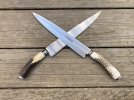
screened porch
Basic Member
- Joined
- Feb 19, 2012
- Messages
- 19,335
I won't tell you what I'd be second-guessing about.I like this knife much better now that I've remedied the rattle.
Admirable nerve and great job.
kamagong
Gold Member
- Joined
- Jan 13, 2001
- Messages
- 10,966
Thank you...lol. The Simbra doesn't have any great sentimental attachment, so it wasn't hard to decide to fix the handle. It was a simple enough fix, all that was needed was patience and focus.I won't tell you what I'd be second-guessing about.
Admirable nerve and great job.
CelloDan
Basic Member
- Joined
- Dec 2, 2017
- Messages
- 3,377
Wow, nice Christian !t was a pretty hot day today, so I finally got off my duff and decided to fix the loose handle on my Simbra

You went from "nah, I just put it in my hot car" to a HOT OVEN
I am happy it all worked out and that it's fixed the issues.
Thanks for sharing !
I checked the ends on my Pampa ( made by La Movediza ) and the big "Martin Fierro"
The "Pampa" verijero's tang is nicely peened and rounded.
The "Martin Fierro" one looks rather crude as in no one bothered to give it even one tap with a ball peen hammer.



Oh I know all rightThanks. I still don't know about the facón, but I have a couple of larger knives
I now that if Christian ever holds an authentic Facon it will be very hard to leave it behind
Cheers
Trubetzkoy
Basic Member
- Joined
- Jun 3, 2022
- Messages
- 424
Speaking of securely peened tangs, check this one out -- it looks like it was peened with Thor's hammer:

It's the tang of a larger antique verijero I've shown previously in this thread, which I suspected to be a Scholberg piece:

As it turns out, my suspicions were correct, as I recently found this Uruguayan Scholberg online with exactly the same chiseled motifs on the sheath, but with a different hook:


It's the tang of a larger antique verijero I've shown previously in this thread, which I suspected to be a Scholberg piece:

As it turns out, my suspicions were correct, as I recently found this Uruguayan Scholberg online with exactly the same chiseled motifs on the sheath, but with a different hook:

kamagong
Gold Member
- Joined
- Jan 13, 2001
- Messages
- 10,966
I checked the ends on my Pampa ( made by La Movediza ) and the big "Martin Fierro"
The "Pampa" verijero's tang is nicely peened and rounded.
The "Martin Fierro" one looks rather crude as in no one bothered to give it even one tap with a ball peen hammer.


I now that if Christian ever holds an authentic Facon it will be very hard to leave it behind
Cheers
The tang on the knives of both
Facónes haven't captured my imagination the same way puñales have. Maybe because they don't appear to have the same quality of craftsmanship. Or perhaps because I already have a Scottish dirk that shares a similar size and purpose to the facón. If you'd like I can post a picture of it next to a puñal for comparison.
Speaking of securely peened tangs, check this one out -- it looks like it was peened with Thor's hammer:

It's the tang of a larger antique verijero I've shown previously in this thread, which I suspected to be a Scholberg piece:

As it turns out, my suspicions were correct, as I recently found this Uruguayan Scholberg online with exactly the same chiseled motifs on the sheath, but with a different hook:

Your Scholberg is a very handsome knife. Though the steel has been ravaged by time and moisture, I am quite impressed by the full blade and its lines. The botón and the Spanish notch are especially nice touches as well.
Trubetzkoy
Basic Member
- Joined
- Jun 3, 2022
- Messages
- 424
Interestingly, my 60's Atahualpa puñal appears to also have a barely peened tang like your Simbra, with quite some space between it and the handle butt hole (can't write that without giggling -- but "pommel" wouldn't be accurate). I wonder if in the second half of the 20th century Argentinian cutlers started to pay less attention to the peening process, since these knives started to be seen more as symbols than as tools. Then again, Dan's Pampa is beautifully peened.
Do share the dirk -- it'd be interesting to see the comparison!

